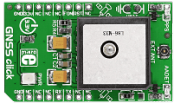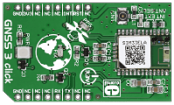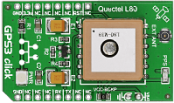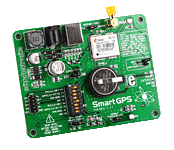 |

|
|
GNSS click carries Quectel’s L86 GNSS module with a patch antenna along with an external antenna connector. GNSS stands for Global Navigation Satellite System, an umbrella term that describes both the United States GPS and the Russian GLONASS global positioning systems. Excluding its wider applicability, the L86 module is similar to the L80 module (used on GPS3 click). It includes the same set of technologies: automatic prediction of orbits from internally stored data, adaptive adjusting of on/off time to balance between positioning accuracy and power consumption etc. The board uses a 3.3V power supply. |
|
|
|
 |

|
|
GNSS3 click carries SIMCom's SIM33ELA standalone GNSS module with an integrated antenna (as well as a connector for an external one). GNSS stands for Global Navigation Satellite System, an umbrella term that describes both the United States GPS and the Russian GLONASS global positioning systems. The SIM33ELA module has MTK's high sensitivity navigation engine. It features EPO orbit prediction, AGPS and SBAS ranging (WAAS, EGNOS, GAGAN, MSAS). GNSS3 click communicates with the target MCU through mikroBUS UART pins (RX, TX), with additional functionality provided through RST and INT pins. The board uses a 3.3V power supply. |
|
|
|
 |

|
|
The GPS click (previously EasyGPS) board is a compact solution for adding GPS functionality to your device. It features the LEA-6S, high performance u-blox 6 positioning engine. Board is organized in mikroBUS form factor. Communication is done using UART or USB connection.
This board can be operated at 3.3V only.
Can be used without a microcontroller by connecting straight to a PC via USB. |
|
|
|
 |

|
|
GPS2 Click is an add-on board in the mikroBUS form factor. It includes the Quectel L30 GPS module as well as an SMA antenna connector. The module has an advanced jamming suppression mechanism and innovative RF architecture ensuring maximum GPS performance. It supports location, navigation and industrial applications including autonomous GPS C/A, SBAS (WAAS or EGNOS) and A-GPS. The board is designed for use with active antennas. SMD jumpers are provided in three groups for selecting between UART, I2C and SPI communication lines. Another SMD jumper is used to select between 3.3V or 5V power supply. |
|
|
|
 |

|
|
GPS3 click carries Quectel's L80 GPS module, a high-sensitivity ultra slim GPS module with a patch antenna. The module incorporates several technologies that enhance the GPS performance. EASY Technology ensures that L80 can calculate and predict orbits automatically using data stored in its internal flash memory. AlwaysLocate technology adaptively adjusts the on/off time to balance between positioning accuracy and power consumption. The Automatic antenna switching function enables switching between the internal patch antenna and the external active antenna, keeping positioning during the switching process. |
|
|
|
 |

|
|
Nano GPS click carries the Nano Hornet module from OriginGPS. It's the smallest GPS module with an integrated patch antenna (measuring just 10x10x3.8mm). Hence, Nano GPS click is also the smallest of all MikroElektronika GPS click boards. Despite its size, it offers superior sensitivity and outstanding performance, with time to first fix (TTFF) of less than 1 second, accuracy of approximately 1m, and tracking sensitivity down to -163dBm. |
|
|
|
 |

|
|
The SmartGPS is a development tool that will help you understand GPS technologies. Connect GPS (Global Positioning System) to your PC or development board using the LEA-6S module. The intuitive design of SmartGPS guides you through the process of learning GPS.
The board features a switching power supply and backup battery, and can be operated at either 3.3V or 5V.
Can be used without a microcontroller by connecting straight to a PC via USB. |
|
|
|
 |

|
|
GSM/GNSS click combines GPS/GLONASS location tracking with GSM module capability for mobile communication. The click features Quectel's MC60 quad-band module. GSM/GNSS click runs on either 3.3V or 5V power supply and communicates with the target MCU over UART interface, and the following mikroBUS™ pins: AN, RST, PWM, INT. |
|
|
|
 |

